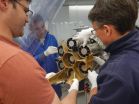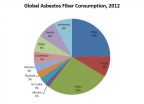(Press-News.org) An enormous spectrum of light streams from the sun. We're most familiar with the conventional visible white light we see with our eyes from Earth, but that's just a fraction of what our closest star emits. NASA regularly watches the sun in numerous wavelengths because different wavelengths provide information about different temperatures and processes in space. Looking at all the wavelengths together helps to provide a complete picture of what's occurring on the sun over 92 million miles away - but no one has been able to focus on high energy X-rays from the sun until recently.
In early December 2014, the Focusing Optics X-ray Solar Imager, or FOXSI, mission will launch aboard a sounding rocket for a 15-minute flight with very sensitive hard X-ray optics to observe the sun. This is FOXSI's second flight - now with new and improved optics and detectors. FOXSI launched previously in November 2012. The mission is led by Säm Krucker of the University of California in Berkeley.
Due to launch from White Sands Missile Range in New Mexico, on Dec. 9, 2014, FOXSI will be able to collect six minutes worth of data during the 15-minute flight. Sounding rockets provide a short trip for a relatively low price - yet allow scientists to gather robust data on various things, such as X-ray emission, which cannot be seen from the ground as they are blocked by Earth's atmosphere.
"Hard X-rays are a signature of particles accelerating on the sun," said Steven Christe, the project scientist for FOXSI at NASA's Goddard Space Flight Center in Greenbelt, Maryland. "The sun accelerates particles when it releases magnetic energy. The biggest events like solar flares release giant bursts of energy and send particles flying, sometimes directed towards the Earth. But the sun is actually releasing energy all the time and that process is not well-understood."
Scientists want to understand these energy releases both because they contribute to immense explosions on the sun that can send particles and energy toward Earth, but also because that energy helps heat up the sun's atmosphere to temperatures of millions of degrees -- 1,000 times hotter than the surface of the sun itself. Observing many wavelengths of light allows us to probe different temperatures within the sun's atmosphere. Looking for hard X-rays, is not only one of the best ways to measure the highest temperatures, up to tens of millions of degrees, but it also helps track accelerated particles.
The sensitivity of the FOXSI instrument means the team can investigate very faint events on the sun, including tiny energy releases commonly known as nanoflares. Nanoflares are thought to occur constantly, but are so small that we can't see them with current telescopes. Spotting hard X-rays with FOXSI would be a confirmation that these small flares do exist. Moreover, it would suggest that nanoflares behave in a similar fashion as larger flares, accelerating particles in much the same way that big flares do.
"It's not necessarily true that these small flares accelerate particles. Perhaps they are just small heating events and the physics is different," said Christe. "That's one of the things we're trying to figure out."
Viewing such faint events requires extra sensitive optics. FOXSI carries something called grazing-incidence optics -- built by NASA's Marshall Space Flight Center in Huntsville, Alabama -- that are unlike any previous ones launched into space for solar observations. Techniques to collect and observe high energy X-rays streaming from the sun have been hampered by the fact that these wavelengths cannot be focused with conventional lenses the way visible light can be. When X-rays encounter most materials, including a standard glass lens, they usually pass right through or are absorbed. Such lenses can't, therefore, be used to adjust the X-ray's path and focus the incoming beams. So X-ray telescopes have previously relied on imaging techniques that don't use focusing. This is effective when looking at a single bright event on the sun, such as the large burst of X-rays from a solar flare, but it doesn't work as well when searching for many faint events simultaneously.
The FOXSI instrument makes use of mirrors that can successfully cause x-rays to reflect -- as long as the x-ray mirrors are nearly parallel to the incoming X-rays. Several of these mirrors in combination help collect the X-ray light before funneling it to the detector. This focusing makes faint events appear brighter and crisper.
The FOXSI launch is scheduled for Dec. 9 between 2 and 3 pm EST. The shutter door on the optics system opens up after the payload reaches an altitude of 90 miles, one minute after launch. FOXSI then begins six minutes of observing the sun. After the observations, the door on the optics system closes. The rocket deploys a parachute and the instruments float down to the ground in the hopes of being used again.
The FOXSI mission made it through this process successfully once before, when it flew in 2012. On its first flight, the telescope successfully viewed a flare in progress. On this second flight, the team has updated some of the optics to be more sensitive and has removed insulation blankets that blocked some of the X-rays during the last flight. They also upgraded some of the detectors with new detectors built by the Japanese Aerospace Exploration Agency using a new detector material. Last time they used silicon and this time they are using cadmium telluride.
Such refurbishing illustrates a key value of sounding rockets: Making adjustments to the instruments on relatively low-cost flights has great benefit for future missions. By testing FOXSI on a sounding rocket, it can be perfected to use on a larger satellite with even larger, more sensitive optics.
In addition to developing technology, these low-cost missions help train students and young scientists.
"Sounding rockets are a great way for students to be heavily involved in every aspect of a space mission, from electronics testing to observational planning," said Lindsay Glesener, FOXSI's project manager at the University of California in Berkeley, who was also a graduate student during FOXSI's first flight. "Development on low-cost missions is the way that,scientists, engineers, and even the telescopes get prepared to work on an eventual satellite mission."
INFORMATION:
FOXSI is a collaboration between the United States and the Japanese Aerospace Exploration Agency. FOXSI is supported through NASA's Sounding Rocket Program at the Goddard Space Flight Center's Wallops Flight Facility in Virginia. NASA's Heliophysics Division manages the sounding rocket program.
COLUMBUS, Ohio - When it comes to specialized cancer surgery, it's generally true that the more experienced the surgeon, the better the outcome. The same might hold true for radiation therapy used to treat head and neck cancer, according to a new study led by researchers Evan Wuthrick, MD, assistant professor of radiation oncology at The Ohio State University Comprehensive Cancer Center - Arthur G. James Cancer Hospital and Richard J. Solove Research Institute (OSUCCC - James), and Maura Gillison, MD, PhD, professor of internal medicine and epidemiology at the OSUCCC - ...
A team of researchers at Dartmouth College and University of Pittsburgh found respondents who had smoked water pipe tobacco but not smoked cigarettes were at increased risk of cigarette smoking two years later as recently published online in JAMA Pediatrics. The study followed 2,541 adolescents and young adults for two years.
Samir Soneji, PhD, a tobacco regulatory control researcher at Dartmouth and lead author on the study said, "We found hookah smoking increased the probability of trying cigarette smoking over the next two years by 19%."
This longitudinal study ...
Drinking or eating from cans or bottles lined with Bisphenol A (BPA) could raise your blood pressure, according to new research reported in the American Heart Association's journal Hypertension.
BPA, a chemical used as an epoxy lining for cans and plastic bottles, is everywhere, and its consumption has been associated with high blood pressure and heart rate variability. Previous studies have shown that BPA can leach into foods and drinks.
"A 5 mm Hg increase in systolic blood pressure by drinking two canned beverages may cause clinically significant problems, particularly ...
Nine in 10 primary care physicians say that prescription drug abuse is a moderate or big problem in their communities and nearly half say they are less likely to prescribe opioids to treat pain compared to a year ago, new Johns Hopkins Bloomberg School of Public Health research suggests.
Primary care doctors also appear to recognize many risks of prescription opioid use, including addiction and death by overdose, according to the findings reported in the Dec. 8 issue of JAMA Internal Medicine.
"Our findings suggest that primary care providers have become aware of the ...
A survey of primary care physicians found the vast majority of practicing internists, family physicians and general practitioners consider prescription drug abuse to be a significant problem in their community and most physicians agreed opioids were overused to treat pain, according to a research letter published online by JAMA Internal Medicine.
Primary care physicians are critical in maximizing the safe use of opioid pain-relieving medications. It is because of this that Catherine S. Hwang, M.S.P.H., of the Johns Hopkins Bloomberg School of Public Health, Baltimore, ...
Smoking water pipe tobacco from hookahs and using the smokeless tobacco snus were associated with initiating cigarette smoking and smoking cigarettes in the past 30 days among previously nonsmoking teenagers and young adults, according to a study published online by JAMA Pediatrics.
The Food and Drug Administration regulates cigarettes, loose tobacco and smokeless tobacco products. However, the FDA does not regulate the manufacturing, distribution and marketing of other tobacco products, such as water pipe tobacco, and many of those products are used by teenagers and ...
Salt Lake City - Develop 100 drugs in 10 years. That's the ambitious goal set by a group of scientists and engineers at the University of Utah, founders of Recursion Pharmaceuticals, a start-up company that is able to quickly and affordably identify unexpected ways a drug could be used by testing it on diseased cells.
The disruptive approach to drug development, aided by custom-designed software capable of tracking changes, or signs of healing, in cells, could speed discovery of therapies for so-called "orphan" diseases.
Scientists at Recursion have already identified ...
(SACRAMENTO, Calif.) -- Children with autism spectrum disorder (ASD) were more than twice as likely to have been exposed in utero to preeclampsia, and the likelihood of an autism diagnosis was even greater if the mother experienced more severe disease, a large study by researchers with the UC Davis MIND Institute has found.
Women with preeclampsia experience hypertension during the latter half of their pregnancies, and may have increased levels of protein in their urine and edema, or fluid retention. Preeclampsia can develop into eclampsia, a life-threatening condition ...
New York, NY, December 8, 2014 - Challenges to global health can evolve from policies and decisions that take years or decades to unfold. An article in the current issue of the Annals of Global Health describes the current state of asbestos use worldwide, a story that began over 100 years ago, and the real and contrived controversies regarding asbestos.
At the peak of asbestos use in 1972 in the United States, more than 775,000 tons of asbestos were used, much of it by the construction trades and shipbuilding industry, in addition to the manufacturing of many consumer ...
There are strong economic incentives for governments to invest in early childhood nutrition, reports a new paper from the University of Waterloo and Cornell University. Published for the Copenhagen Consensus Centre, the paper reveals that every dollar spent on nutrition during the first 1,000 days of a child's life can provide a country up to $166 in future earnings.
"The returns on investments in nutrition have high benefit-cost ratios, especially in countries with higher income levels and a growing economy," said Professor Susan Horton, of the School of Public Health ...

